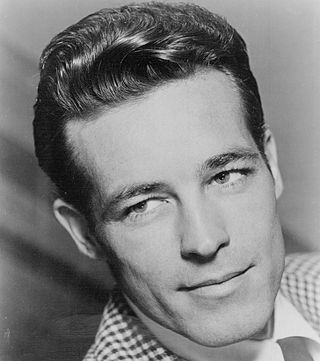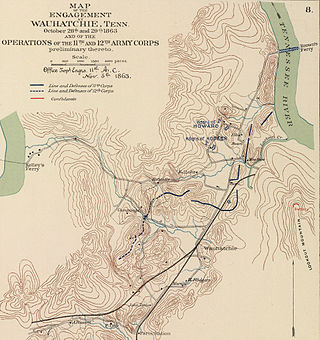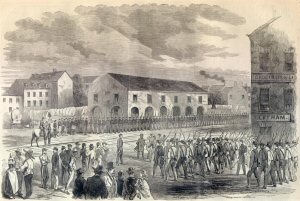
The Richmond–Petersburg campaign was a series of battles around Petersburg, Virginia, fought from June 9, 1864, to March 25, 1865, during the American Civil War. Although it is more popularly known as the Siege of Petersburg, it was not a classic military siege, in which a city is encircled with fortifications blocking all routes of ingress and egress, nor was it strictly limited to actions against Petersburg. The campaign consisted of nine months of trench warfare in which Union forces commanded by Lt. Gen. Ulysses S. Grant assaulted Petersburg unsuccessfully and then constructed trench lines that eventually extended over 30 miles (48 km) from the eastern outskirts of Richmond, Virginia, to around the eastern and southern outskirts of Petersburg. Petersburg was crucial to the supply of Confederate Gen. Robert E. Lee's army and the Confederate capital of Richmond. Numerous raids were conducted and battles fought in attempts to cut off the Richmond and Petersburg Railroad. Many of these battles caused the lengthening of the trench lines.

Duel in the Sun is a 1946 American epic psychological Western film directed by King Vidor, produced and written by David O. Selznick, and starring Jennifer Jones, Joseph Cotten, Gregory Peck, Lillian Gish, Walter Huston, and Lionel Barrymore. Based on the 1944 novel of the same name by Niven Busch, it follows a young orphaned Mestiza woman who experiences prejudice and forbidden love, while residing with her white relatives on a large Texas ranch.

The Battle of Chickamauga, fought on September 18–20, 1863, between the United States Army and Confederate forces in the American Civil War, marked the end of a U.S. Army offensive, the Chickamauga Campaign, in southeastern Tennessee and northwestern Georgia. It was the first major battle of the war fought in Georgia, the most significant US defeat in the Western Theater, and involved the second-highest number of casualties after the Battle of Gettysburg.

Sherman's March to the Sea was a military campaign of the American Civil War conducted through Georgia from November 15 until December 21, 1864, by William Tecumseh Sherman, major general of the Union Army. The campaign began on November 15 with Sherman's troops leaving Atlanta, recently taken by Union forces, and ended with the capture of the port of Savannah on December 21. His forces followed a "scorched earth" policy, destroying military targets as well as industry, infrastructure, and civilian property, disrupting the Confederacy's economy and transportation networks. The operation debilitated the Confederacy and helped lead to its eventual surrender. Sherman's decision to operate deep within enemy territory without supply lines was unusual for its time, and the campaign is regarded by some historians as an early example of modern warfare or total war.

The Battle of Stones River, also known as the Second Battle of Murfreesboro, was fought from December 31, 1862, to January 2, 1863, in Middle Tennessee, as the culmination of the Stones River Campaign in the Western Theater of the American Civil War. Of the major battles of the war, Stones River had the highest percentage of casualties on both sides. The battle ended in Union victory after the Confederate army's withdrawal on January 3, largely due to a series of tactical miscalculations by Confederate Gen. Braxton Bragg, but the victory was costly for the Union army. Nevertheless, it was an important victory for the Union because it provided a much-needed boost in morale after the Union's recent defeat at Fredericksburg and also reinforced President Abraham Lincoln's foundation for issuing the Emancipation Proclamation, which ultimately discouraged European powers from intervening on the Confederacy's behalf.

The Atlanta campaign was a series of battles fought in the Western Theater of the American Civil War throughout northwest Georgia and the area around Atlanta during the summer of 1864. Union Maj. Gen. William Tecumseh Sherman invaded Georgia from the vicinity of Chattanooga, Tennessee, beginning in May 1864, opposed by the Confederate general Joseph E. Johnston.

The Horse Soldiers is a 1959 American adventure war film set during the American Civil War directed by John Ford and starring John Wayne, William Holden and Constance Towers. The screenplay by John Lee Mahin and Martin Rackin was loosely based on the Harold Sinclair (1907-1966) 1956 novel of historical fiction of the same name, a fictionalized version of the famous Grierson's Raid by Federal cavalry in April-May 1863 riding southward through Mississippi and around the Mississippi River fortress of Vicksburg during the Vicksburg campaign to split the southern Confederacy by Union Army Gen. Ulysses S. Grant.

The Battle of Missionary Ridge, also known as the Battle of Chattanooga, was fought on November 25, 1863, as part of the Chattanooga campaign of the American Civil War. Following the Union victory in the Battle of Lookout Mountain on November 24, Union forces in the Military Division of the Mississippi under Maj. Gen. Ulysses S. Grant assaulted Missionary Ridge and defeated the Confederate Army of Tennessee, commanded by Gen. Braxton Bragg, forcing it to retreat to Georgia.

The Battle of Hoover's Gap was the principal battle in the Tullahoma Campaign of the American Civil War, in which Union General William S. Rosecrans drove General Braxton Bragg’s Confederates out of Central Tennessee. Rosecrans’ feigned move on the western end of the Confederate line had left the eastern mountain passes lightly defended, and Colonel John T. Wilder's mounted infantry achieved total surprise when they attacked Hoover's Gap. Success was attributed both to Rosecrans’ brilliant deception tactics and the high morale of Wilder’s "Lightning Brigade", equipped with the new Spencer repeating rifle.

Guy Madison was an American film, television, and radio actor. He is best known for playing Wild Bill Hickok in the Western television series The Adventures of Wild Bill Hickok from 1951 to 1958.

The Battle of Wauhatchie was fought October 28–29, 1863, in Hamilton and Marion counties, Tennessee, and Dade County, Georgia, in the American Civil War. A Union force had seized Brown's Ferry on the Tennessee River, opening a supply line to the Union army in Chattanooga. Confederate forces attempted to dislodge the Union force defending the ferry and again close this supply line but were defeated. Wauhatchie was one of the few night battles of the Civil War.

The Second Battle of Ream's Station was fought during the siege of Petersburg in the American Civil War on August 25, 1864, in Dinwiddie County, Virginia. A Union force under Maj. Gen. Winfield S. Hancock began destroying part of the Petersburg Railroad, which was a vital supply line for Gen. Robert E. Lee's Confederate army in Petersburg, Virginia. Lee sent a force under Lt. Gen. A. P. Hill to challenge Hancock and the Confederates were able to rout the Union troops from their fortifications at Reams Station. However, they lost a key portion of the railroad, causing further logistical difficulties for the remainder of the Richmond-Petersburg Campaign.

The Battle of Munfordville was an engagement in Munfordville, Kentucky during the American Civil War. Victory there allowed the Confederates to temporarily strengthen their hold on the region and impair Union supply lines.

Val Lewton was a Ukrainian-American novelist, film producer and screenwriter best known for a string of low-budget horror films he produced for RKO Pictures in the 1940s. His son, also named Val Lewton, was a painter and exhibition designer.

James Craig was an American actor. He is best known for appearances in films like Kitty Foyle (1940) and The Devil and Daniel Webster (1941), and his stint as a leading man at Metro-Goldwyn-Mayer in the 1940s where he appeared in films like The Human Comedy (1943).

The Carolinas campaign, also known as the campaign of the Carolinas, was the final campaign conducted by the Union Army against the Confederate Army in the Western Theater of the American Civil War. On January 1, Union Maj. Gen. William T. Sherman advanced north from Savannah, Georgia, through the Carolinas, with the intention of linking up with Union forces in Virginia. The campaign culminated in the defeat of Confederate Gen. Joseph E. Johnston's army at the Battle of Bentonville, and its unconditional surrender to Union forces on April 26, 1865. Coming just two weeks after the defeat of Robert E. Lee's army at the Battle of Appomattox Court House, it signaled that the war was effectively over.

The western theater of the American Civil War encompassed major military operations in the states of Alabama, Georgia, Florida, Mississippi, North Carolina, Kentucky, South Carolina and Tennessee, as well as Louisiana east of the Mississippi River. Operations on the coasts of these states, except for Mobile Bay, are considered part of the Lower Seaboard Theater. Most other operations east of the Appalachian Mountains are part of the eastern theater. Operations west of the Mississippi River took place in the trans-Mississippi theater.

The city of Winchester, Virginia, and the surrounding area, were the site of numerous battles during the American Civil War, as contending armies strove to control the lower Shenandoah Valley. Winchester changed hands more often than any other Confederate city.

The Chattanooga campaign was a series of maneuvers and battles in October and November 1863, during the American Civil War. Following the defeat of Maj. Gen. William S. Rosecrans's Union Army of the Cumberland at the Battle of Chickamauga in September, the Confederate Army of Tennessee under Gen. Braxton Bragg besieged Rosecrans and his men by occupying key high terrain around Chattanooga, Tennessee. Maj. Gen. Ulysses S. Grant was given command of Union forces in the West which was now consolidated under the Division of the Mississippi. Significant reinforcements also began to arrive with him in Chattanooga from Mississippi and the Eastern Theater. On October 18, Grant removed Rosecrans from command of the Army of the Cumberland and replaced him with Major General George Henry Thomas.
Forrest's Expedition into West Tennessee was a raid conducted by Confederate Brigadier General Nathan Bedford Forrest in Tennessee from December 1862 to January 1863, during the American Civil War. Forrest led an expedition of 1,800 to 2,500 men into Union-held West Tennessee to disrupt the supply lines of Major General Ulysses S. Grant, who was campaigning south along the Mississippi River toward Vicksburg.



















